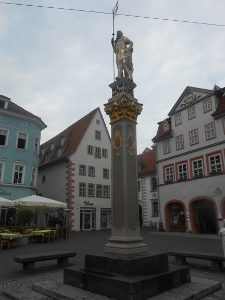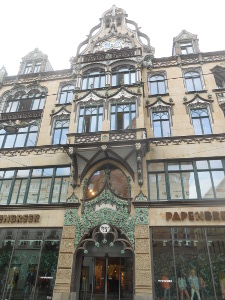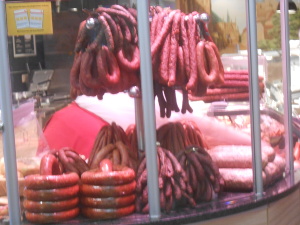 Repairing a city statue
we but known we could have taken the tram three stops from the train station to the hotel, but we didn't know, so we had a nice taxicab ride.
Repairing a city statue
we but known we could have taken the tram three stops from the train station to the hotel, but we didn't know, so we had a nice taxicab ride.
Our trip from Chemnitz to Erfurt involved two trains and many stops, but we made it just fine. Had  Repairing a city statue
we but known we could have taken the tram three stops from the train station to the hotel, but we didn't know, so we had a nice taxicab ride.
Repairing a city statue
we but known we could have taken the tram three stops from the train station to the hotel, but we didn't know, so we had a nice taxicab ride.
Our room wasn't quite ready, so we had lunch and rode the tram downtown and visited the tourist office near the old Fischmarkt where we observed the workmen taking a statue down from the rathaus for repair, and saw the statue of a soldier with the regalia of the Roman republic, placed by the city fathers in lieu of the Roland statue which could only be erected by a free imperial city, which Erfurt was not. We noticed that the dom is actually two churches side by side on a high hill: a cathedral and a parish church. There are seventy-three steps leading up to the churches from the Domplatz.
The next morning we did the laundry; after a nice German luncheon we climbed up to see the two  The Roman in Erfurt
churches, both of them beautiful and gothic, dating to the 14th century. Coming down the steps we came upon a wedding party and a photographer, and also tried to figure out the charity event that was being set up in the Domplatz; it had to do with organ transplants.
The Roman in Erfurt
churches, both of them beautiful and gothic, dating to the 14th century. Coming down the steps we came upon a wedding party and a photographer, and also tried to figure out the charity event that was being set up in the Domplatz; it had to do with organ transplants.
A top thing to do in Erfurt is take a historic walk through the old city. We took the walk outlined in the pamphlet we got at the tourist office, and it was quite beautiful. There were many tour groups being lectured to in one language or another, but we were proud to be self-guided. The big sight is Kramerbrucke, the bridge of houses -- actually a stone arched bridge with houses erected on the bridge road. Crossing the bridge is like walking a narrow alley -- you don't see the river, just the dozens of  The two churches on the hill
interesting shops which line the road on both sides. So our best picture was taken on the walk looking at the back side of the houses.
The two churches on the hill
interesting shops which line the road on both sides. So our best picture was taken on the walk looking at the back side of the houses.
Saturday the Domplatz was filled with a big weekly market and the loudspeaker was blaring in the runup to Sunday's charity event. We found a nice Asian restaurant and had Thai duck and pork curry and managed to return to the hotel just before the rain started.
We brought an inexpensive tablet to Europe, but on Sunday morning we experienced some panic until we figured out the wireless mouse was dead, meaning we had to replace the battery. We thought of going to the hauptbahnhof, where a replacement battery was readily located.
 Kramerbrucke
Kramerbrucke
A little while after that we were back on the tram to the history museum, which was a real winner, well organized exhibits in an ancient building, with stairs to climb and descend, which we are in good enough shape now to do without any whining.
The special exhibit, with some English captions, was about the effect of Martin Luther, who became a monk here in Erfurt at the Augustinian monastery, in the late 16th century. That was before he hammered up the 95 theses, and the exhibits told us more.
There were three or four monasteries in or near Erfurt at the time. Besides the Augustinians there were Benedictines and Franciscans and Dominicans. They were somewhat resented by the regular  Half-timbered houses
clergy, because they did not have the pressure from the church hierarchy; the monasteries were administered directly from offices in the Vatican.
Half-timbered houses
clergy, because they did not have the pressure from the church hierarchy; the monasteries were administered directly from offices in the Vatican.
The monks had lots of time to study, and had good libraries. Possibly Luther had access to a book of writings by Johann Hus, the Czech heretic who was burned for his liberal ideas. In any case, the church had grown loose, indulgences were a big problem.
The monasteries interacted with the local citizenry in a different way, too. They provided a different kind of religious services, also religious education, and they attracted away the best and brightest to join the orders.
 Beautifully painted inn
Beautifully painted inn
The exhibition did not go into the strife caused by the Reformation, or how it was resolved. It was primarily about the intellectual problems that the monasteries introduced into an already deeply religious populace by casting doubts upon the official Catholic hierarchy.
After an hour or more of Luther we listened to the persuasive advice of the museum staff and ascended the next floor for the first of two floors on city history -- a series of very thought-provoking exhibits that explored the holocaust, the capture of bin Laden, Nazism, the communist takeover, not to mention previous history going back at least a thousand years. There was a movie which showed the way buildings came and went (there were several large city fires over that millenium), there  Magnificent art nouveau
were samples of local industries such as typewriters, manual and electric, even crematoria that were unfortunately put to the wrong use at Auschwitz.
Magnificent art nouveau
were samples of local industries such as typewriters, manual and electric, even crematoria that were unfortunately put to the wrong use at Auschwitz.
Erfurt was never an independent city, always part of Thuringia (until it was annexed by Prussia). Since then, Erfurt became part of the German Empire, then the Weimar Republic, then the Fascist Nazi state, then the communist German Democratic Republic, and most recently, in 1990, part of the reunited country of Germany. All this shuffling about, but the citizens of Erfurt just kept their heads down and did their work and lived their lives, yet keeping alive that spirit of inquiry that was represented by the University.
A good history museum gets you to thinking and this was a good museum. Having had four weeks of exposure to the German language we did better guessing at the meanings of the exhibit signs. We  German national food?
realized that a city that has been around a thousand years has a great deal to remember. Why, for example, was the University opened in 1379, closed in 1816, and reopened in 1994? All we've gleaned so far is that Erfurt became part of Prussia and the university was closed by the Prussian government. Did this closure have anything to do with Napoleon?
German national food?
realized that a city that has been around a thousand years has a great deal to remember. Why, for example, was the University opened in 1379, closed in 1816, and reopened in 1994? All we've gleaned so far is that Erfurt became part of Prussia and the university was closed by the Prussian government. Did this closure have anything to do with Napoleon?
We went to the train station for bratwurst and hafenpeter (aka steak tartare) sandwiches for lunch, and returned happily to the hotel. Along the way at the DomPlatz a lot of cars were parked. It was an auto show for old cars made in Erfurt we think.
Compared with Chemnitz, Erfurt is much more beautiful, softened by trees and parks, and more prosperous. We are very happy we came.